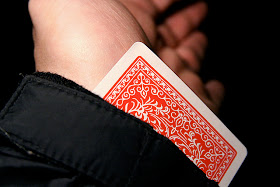 Fooling Houdini: Magicians, Mentalists, Math Geeks, and the Hidden Powers of the Mind by Alex Stone (New York: Harper Collins, 2012. 291 pp)
Fooling Houdini: Magicians, Mentalists, Math Geeks, and the Hidden Powers of the Mind by Alex Stone (New York: Harper Collins, 2012. 291 pp)
Alex Stone has written for Harper’s, Discover, Science, and the Wall Street Journal. He graduated from Harvard University with a degree in English and has a master’s degree in physics from Columbia University. He grew up in Wisconsin, Texas, and Spain. He currently lives in New York City.
Magic and Me
I’ve always loved the art of deception. I had a small magic kit as a child, complete with a card deck and plastic magic wand. I, however, lacked the patience to learn the dexterity of sleight of hand or even a decent shuffle. To this day, I still have trouble shuffling cards for a poker game. But, I still value the medium, and enjoy watching stars like Blaine, Copperfield, or even Penn and Teller. My love story, however, pales in comparison to Alex Stone’s, a tale he recounts in Fooling Houdini.
The Magic Olympics
 |
| Photo by Steven Depolo |
In a quest to redeem his failure at the conjurer’s art, and even fool the masters, he studies with anyone and everyone he can. The first person he meets is Jeff McBride, leader of the Mystery School. McBride holds three Guinness World Records for his card handling abilities, and was crowned magician of the year by the Academy of Magical Arts. He’s a big deal. So, Stone goes to school.
“McBride likes to call his school ‘Hogwarts for grownups,’ and what happened on the first day was straight out of Harry Potter. To begin with, we were asked to congregate around a flame burning at the center of the room atop an iron pedestal. The shutters had been drawn against the January light, and it was murky inside. As we rose to our feet the flame trembled, casting a ripple of shadows on the walls. Contorted by the shifting play of light, the masks seemed to flicker awake in a momentary flash of borrowed life” (35).
Magical Archetypes
Here, Stone learns of four archetypes of the magician: Trickster, Sorcerer, Oracle, and Sage. Stone sadly realizes that he has remained in the cycle of Trickster for quite some time, but that only renews his fervor to continue his journey as a magician. Stone, then, decides to find someone under which to apprentice, discovering master illusionist Wesley James, now retired. Wesley basically lives at a pizzeria.
“One weekend turned into many. Saturdays at the pizzeria became my newest ritual—harking back to the one that began in my early childhood, when my father would take me to the magic store on the weekends. My friends and family soon learned not to call me on Saturdays; I observed the magic Sabbath more faithfully than the Hebrew one. (I may be half Jewish, but I’m all magician)” (52).
Breaking the Code
 |
| Photo by Steven Depolo |
“Keeping a magic trick secret clearly isn’t the same thing as hiding a childhood trauma or an extramarital affair. Nonetheless, the double-edged nature of secrecy goes a long way toward explaining what makes magic, and the people who practice it, so unusual” (135).
Stone describes the mechanics of wristwatch stealing, cardsharping, and finger calisthenics within the book. But, what’s worse is his first attempt at exposing trade secrets occurred in a Harper’s magazine article, a mainstream magazine for the laypeople.
Stone was shunned from the magical community altogether, had he written for a magical magazine, the punishment wouldn’t be harsh, but alas he plays his cards (pun intended) foolishly. Few have forgiven him, and even his mentor Wes found it hard to do so. But, the truth is this kind of thing happens all the time. Stone cites magician Val Valentino, known for his television special Breaking the Magician's Code: Magic's Biggest Secrets Finally Revealed. So, the magical community has moved on, somewhat. If they can forgive Val Valentino, why not Stone?
Fooling is Bliss
Nonetheless, Stone continues on the journey to become a master, and finds a way to fool his mentors (I won’t tell you how). After all,
“[T]he biggest draw is that it’s just plain fun to fool people. Anyone who claims otherwise—that fooling people isn’t one of magic’s central joys, one of its primary pleasures—is being dishonest. To truly astonish someone, to freak them out so badly they can’t sleep at night, to blow their mind and make them question their sanity—that, to me, as to all magicians, is heaven. It’s one of the chief upsides to becoming a magician, aside from the fact that black is very slimming” (172).
If you want a journey from failure to discovery to magic tricks and mentalism, Fooling Houdini is a fantastic memoir. Alex Stone proves himself to be a great story teller of magical proportion.
No comments:
Post a Comment